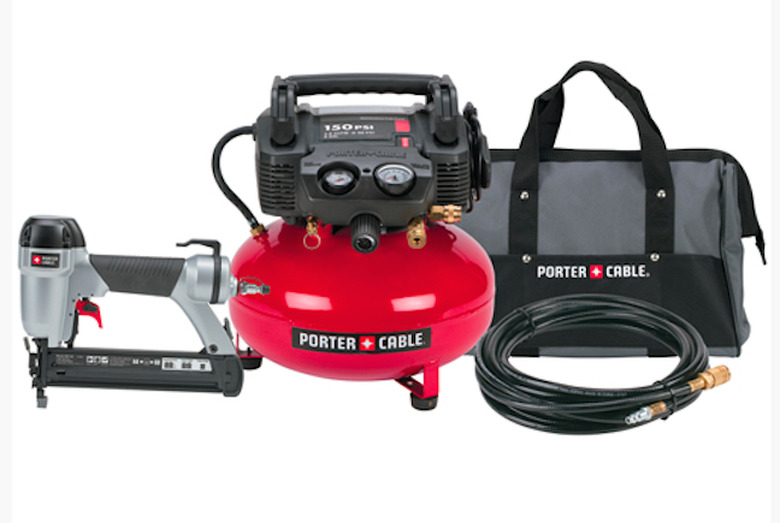How To Use Air Compressors: The Basics
Air compressors were once found in the garages or workshops of only the most dedicated home crafters and mechanics, but with a wide variety of smaller compressors now available, they are no longer tools for only professionals or veteran DIYers. They can power numerous air-powered (pneumatic) tools used for many applications.
Air compressors operate by storing compressed air in a steel tank and releasing it in a controlled manner to operate a variety of tool attachments, from air wrenches to sanding and grinding equipment to air nailers to painting tools. An electrical motor on the compressor unit pumps air into a storage tank under pressure and maintains it at high enough pressure to power the tools, which connect to the tank via air hoses. In normal tool operation, the compressor's motor will kick in and shut off automatically as air pressure fluctuates in the tank. When running a paint sprayer, for example, you will hear the electric motor kick in as the air in the tank drops, and it will shut down each time the tank pressure reaches its set limit.
The advantage of using pneumatic tools is that you don't need a whole collection of tools, each with its own motor. Instead, a single motor-driven air compressor can power a whole collection of relatively inexpensive attachments. Pneumatic tools can also generate more power than many hand-held electrical tools.
Air compressors are sold by many manufacturers, including Sears Craftsman, Porter Cable, Bostitch, DeWalt, Stanley and Makita. Mechanically, air compressors use one of several design styles — some with automotive-style pistons that require oil to keep them operating properly. These piston-style compressors tend to be higher-power models used to operate larger tools. For more modest jobs, diaphragm-style compressors are available; they use no oil, but create a seal using a rubber diaphragm. The oil-less diaphragm compressors have become very popular among homeowners, and are useful for operating air nailers, paint sprayers and other smaller equipment.
Here are some basic instructions for using air compressors, common to all models.
Things Needed
-
Air compressor
-
Air hose
-
Adjustable wrench
-
Teflon tape
-
Air tools
Warning
Never leave the air compressor switched on and left unattended. If the compressor does not shut off automatically after the air pressure gauge reaches 115 pounds per square inch, unplug the compressor and have it serviced before using the compressor again. The air tank could burst from excess air pressure.
1. Plug in the Compressor
Place the compressor on a firm, flat work area. Make sure the power switch is turned off. Plug the power cord into a grounded (three-pronged) electrical outlet.
Tip
Always wear safety goggles when using air tools. Use ear protection if you will be working around the compressor for long periods of time.
2. Check the Oil
If your compressor is a piston-type, make sure there is sufficient oil in the crankcase. Check the oil level by peering into the sight gauge at the bottom of the compressor motor. If necessary, remove the oil filler cap, and add compressor oil to bring the level up to the full mark on the gauge. Check the oil level after each use.
3. Fill the Air Tank
Make sure the drain valve is closed at the bottom of the air tank by tightening it with an adjustable wrench in a clockwise direction. Turn the power switch on and allow the compressor to run a few minutes. Check the built-in air gauge and make sure the compressor shuts off automatically when the air pressure reaches 100 to 115 psi. The pressure capacity of the tank will vary, depending on the model.
4. Adjust the Air Control Valve
Adjust the air control valve to match the maximum allowed air pressure on the air tool that you will be using. Do this by turning the air control valve in either direction until the air pressure gauge reads the correct air pressure for the tool.
5. Connect Air Hose
Connect an air hose to the compressor, making sure the length is sufficient to reach the work area. Wrap the threaded end of the air hose with two layers of Teflon tape, and then thread the hose onto the compressor fitting (located near the air pressure gauge). Tighten it in a clockwise direction with an adjustable wrench.
Some compressors may have quick-connect hose fittings to connect to the air tank.
6. Connect the Pneumatic Tool
Connect your air tool to the other end of the air hose, using the quick-connect fitting. Pull back on the spring-loaded collar on the hose, and push it firmly onto the air intake on the tool. Release the collar to secure the connection.
To disconnect the tool, pull back on the collar while pulling the tool off the air hose.
7. Drain Moisture After Use
Drain the moisture from the air tank periodically (check your owner's manual for recommendations) by loosening and removing the drain valve at the bottom of the tank with an adjustable wrench in a counterclockwise direction. When all water has drained from the tank, replace the drain valve and tighten it in a clockwise direction.

